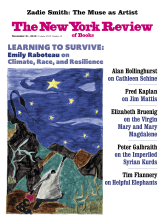In response to:
The Invention of Time from the November 7, 2019 issue
To the Editors:
Glen Bowersock’s identification of the event depicted in the Huqoq Elephant Mosaic overlooks other possible interpretations, some of which seem more likely [“The Invention of Time,” NYR, November 7]. He suggests that the sole reason for Jews in late Roman Palestine to have shown an interest in the Seleucid past would have been connected to the events of the Maccabean revolt. However, in our publication on the Elephant Mosaic we explored various interpretations, including other lines of engagement with Seleucid history among the Jews of late Roman Galilee aside from the festival of Hanukkah and the narratives associated with it (see Karen Britt and Ra‘anan Boustan, The Elephant Mosaic Panel in the Synagogue at Huqoq, Journal of Roman Archaeology Supplementary Series, 2017). Sources ranging from rabbinic literature to Jewish liturgical poetry to Hellenistic-era inscriptions found in synagogue buildings demonstrate that Jewish communities from Asia Minor to Syria and Palestine were living in a world saturated by memories of the Seleucids. In many respects, Bowersock’s presentation of Jewish interest in the Seleucid past does not adequately capture the profound implications of Paul Kosmin’s work for Jewish culture, not only during the Hellenistic period but also for the better part of a millennium afterwards.
Ra‘anan Boustan
Princeton University
Princeton, New Jersey
Karen Britt
Northwest Missouri State University
Maryville, Missouri
G.W. Bowersock replies:
As Dr. Boustan knows, I have spoken with him in Princeton about the many biblical allusions in the images at Huqoq. I observed in our discussions and also in my review that current debate about the Elephant Mosaic is “inconclusive,” because there is no consensus about what it represents. I cited what I considered the most reasonable interpretation and in fact supported a Seleucid date. I nowhere suggested that the Maccabean revolt was “the sole reason” for Jewish interest in the Seleucids. I am not sure why Boustan and Britt stress a point on which we agree, namely that the Jews lived in a world “saturated by memories of the Seleucids,” except perhaps to signal that they have views of their own about the mosaic.
This Issue
November 21, 2019
The Defeat of General Mattis
The Muse at Her Easel
Lessons in Survival



